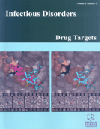-
s Tetraspanins - Gateways for Infection
- Source: Infectious Disorders - Drug Targets (Formerly Current Drug Targets - Infectious Disorders), Volume 12, Issue 1, Feb 2012, p. 4 - 17
-
- 01 Feb 2012
Abstract
The tetraspanins constitute a conserved superfamily of four-span membrane proteins that are widely distributed in multi-cellular organisms. A characteristic property of tetraspanins is their ability to form lateral associations with one another and with other membrane proteins, giving rise to tetraspanin enriched microdomains (TEM) that are involved in the molecular organisation of many membrane-associated functions such as adhesion, fusion and trafficking. Increasing evidence suggests that intracellular pathogens, especially viruses, have “hijacked” tetraspanins as a means of entering, traversing and exiting cells during the course of infection. This article reviews current evidence for the role of tetraspanins in the uptake, trafficking and spread of viruses as well as intracellular bacteria, fungi and parasites. Finally, the prospects of targeting tetraspanins for therapeutic intervention in infections caused by such pathogens are discussed.


